Global Domains and Handles |

|

|

|

|
|
Global Domains and Handles |

|

|

|

|
Global domains are represented by a cube made up of dashed lines. Global domains are located at the centroid of the nodes which make up the global domain. Global handles are the largest handles in the model. Global handles are red if they are not dependent on other handles. Global handles are yellow, cyan, or violet if they are dependent on other handles, the color indicating their level of dependency. Dependent global handles are also smaller than the handles on which they are dependent. The base size of all the handles in the model can be set on the morphing Visualization Controls tab accessed by using the Visualization Options icon ![]() on the Visualization toolbar. The size given is used as the radius for the independent global handles. You cannot edit the color of the handles nor the relative size between the dependent and independent handles. However, you can edit the color of the domains in the morphing Visualization Controls tab.
on the Visualization toolbar. The size given is used as the radius for the independent global handles. You cannot edit the color of the handles nor the relative size between the dependent and independent handles. However, you can edit the color of the domains in the morphing Visualization Controls tab.
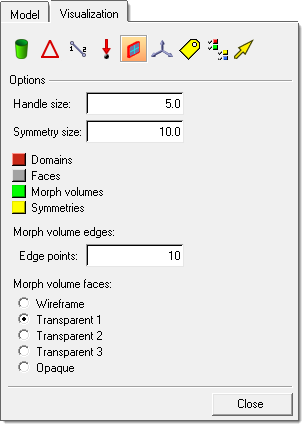
The Domains panel is used to create, edit, and organize global domains. When a global domain is created with the create handles option turned on HyperMorph generates several global handles. Global handles are generated at each of the eight corners of a box surrounding the model laid out along the global axes. These global handles are named corner followed by a number from one to eight. HyperMorph also places at least one global handle within the global domain box in areas of peak nodal density within the model. HyperMorph generally creates no more than about 30 global handles within the global domain box. These handles are named global followed by a number. The automatic global handle generation works particularly well for space frame models such as full car models. If the handles are not generated in the positions where you want them to be, you can always delete them, reposition them, or create new handles using the Handles panel.
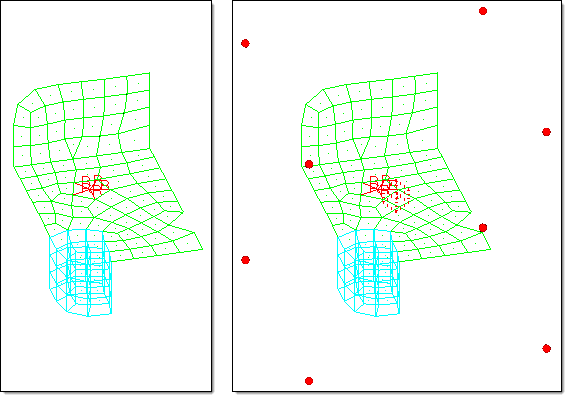
Example of a model with a global domain and global handles.
Eight handles are placed at the corners of a box enclosing the model. By moving the handles you can stretch or deform the model along all three axes.
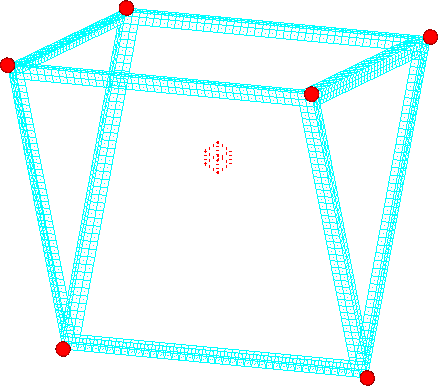
A space frame with six manually created global handles.
When the handles are moved, the space frame morphs in a way such that the bars run between the handles.
There are three options for determining how global handles associated with global domains influence the mesh: the hierarchical method, the direct method, and the mixed method. In the hierarchical method, global handles influence the local handles found at nodes inside the global domain, which in turn influence nodes within the local domains. In the direct method, global handles influence the nodes in the model directly even if the nodes are not in a local domain. In the mixed method, global handles will influence every node inside the global domain using the hierarchical method if the node is inside a local domain, or the direct method if the node is not in a local domain. The method used can be selected in the global subpanel of the Morph Options panel. The default method is the direct method method. There are subtle differences in how the global handles influence the nodes for each method with the main difference being that the parts of the model defined by local edge domains have their shape preserved when using the hierarchical method. Straight edges will remain straight and circular holes will remain circular for the hierarchical method, while the direct method may bend or warp these features into curved edges and elliptical holes. You should select which method is right for the type of morphing that you want to perform. If you wish to preserve the local geometry, choose the hierarchical or mixed method. If you are willing to accept distortions in the local geometry, choose the direct method.
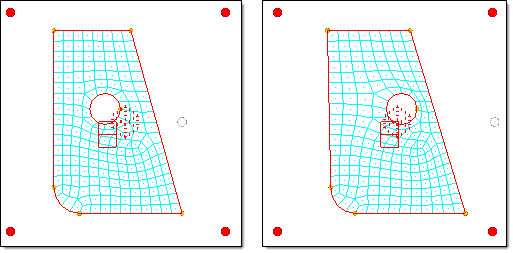
An example of global morphing using the hierarchical method.
When the highlighted (white) handle is moved to the right, it moves the local handles, which move the mesh. Note how the straight edge remains straight and the circle remains round.
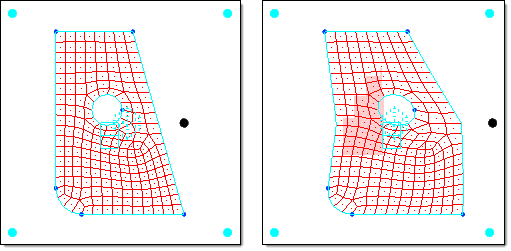
An example of global morphing using the direct method.
When the highlighted (white) handle is moved to the right, the mesh is affected directly. Note the resulting distortion of the edge and circle.
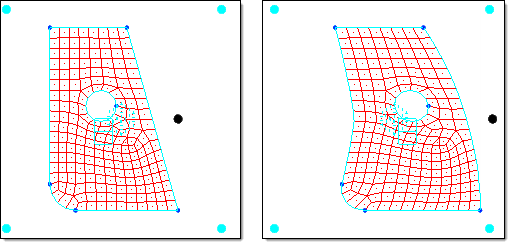
An example of global morphing using the direct method and biasing factors.
By increasing the biasing factor for the highlighted (white) handle, the angular shape of the morph becomes rounded.
The influences between the global handles and local handles using the hierarchical method or nodes using the direct method can be calculated using either the spatial method or the geometric method. Both methods attempt to determine how a global handle affects nodes or local handles in the space surrounding it. The spatial method is the default, and is the fastest and most robust method for generating global influences based on a spatial formulation for the entire model. The geometric method can be slow for large models or large numbers of global handles, but may produce more desirable influences. The geometric method is the method that was originally used in HyperMesh and generates influences based on the geometric relationship between a given node or local handle and the surrounding global handles. The method used can be selected in the global subpanel of the Morph Options panel.